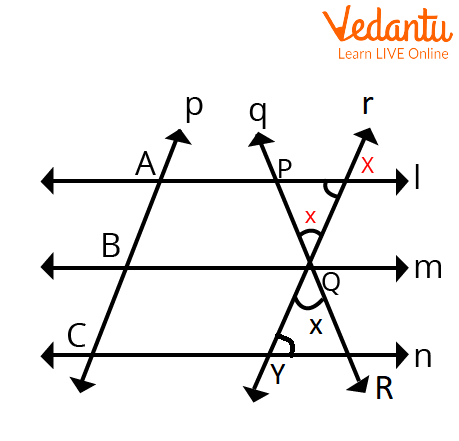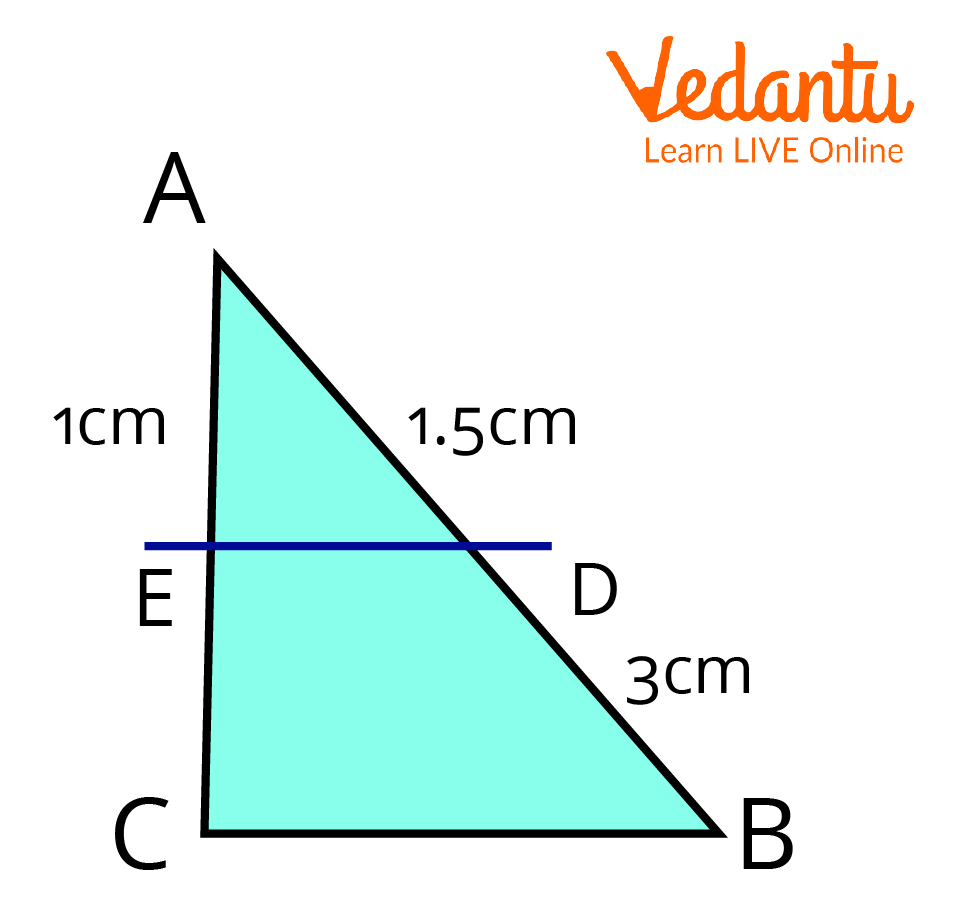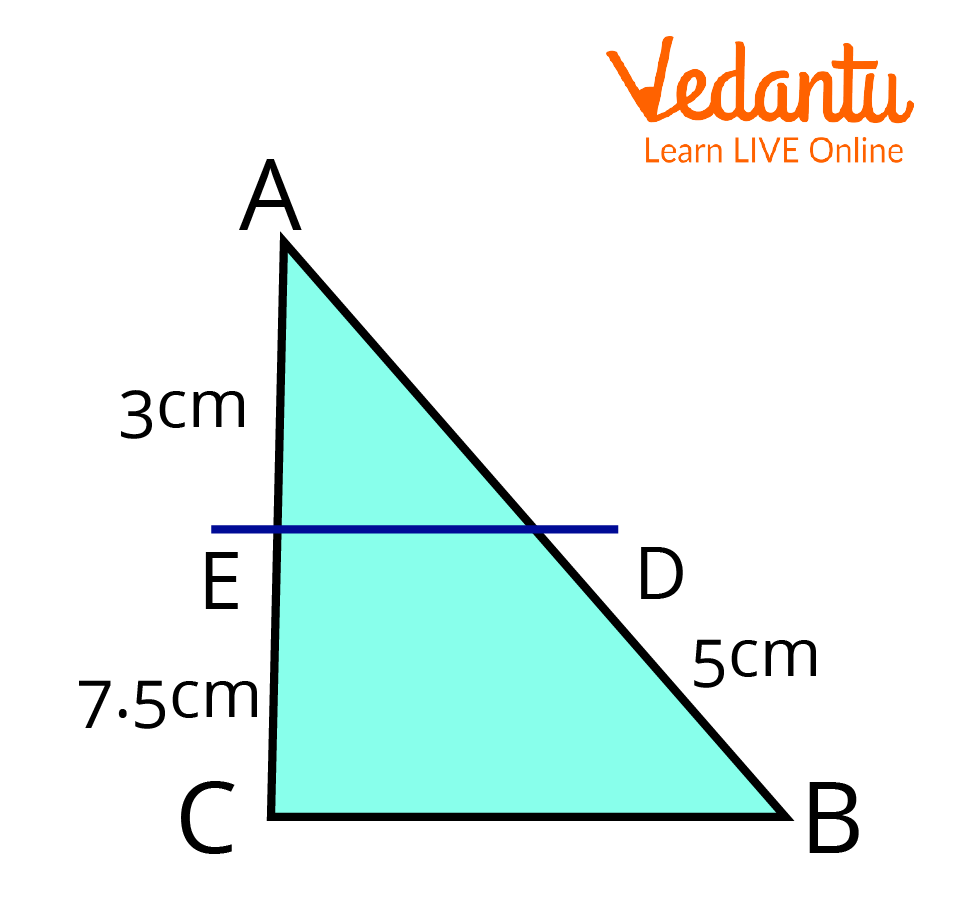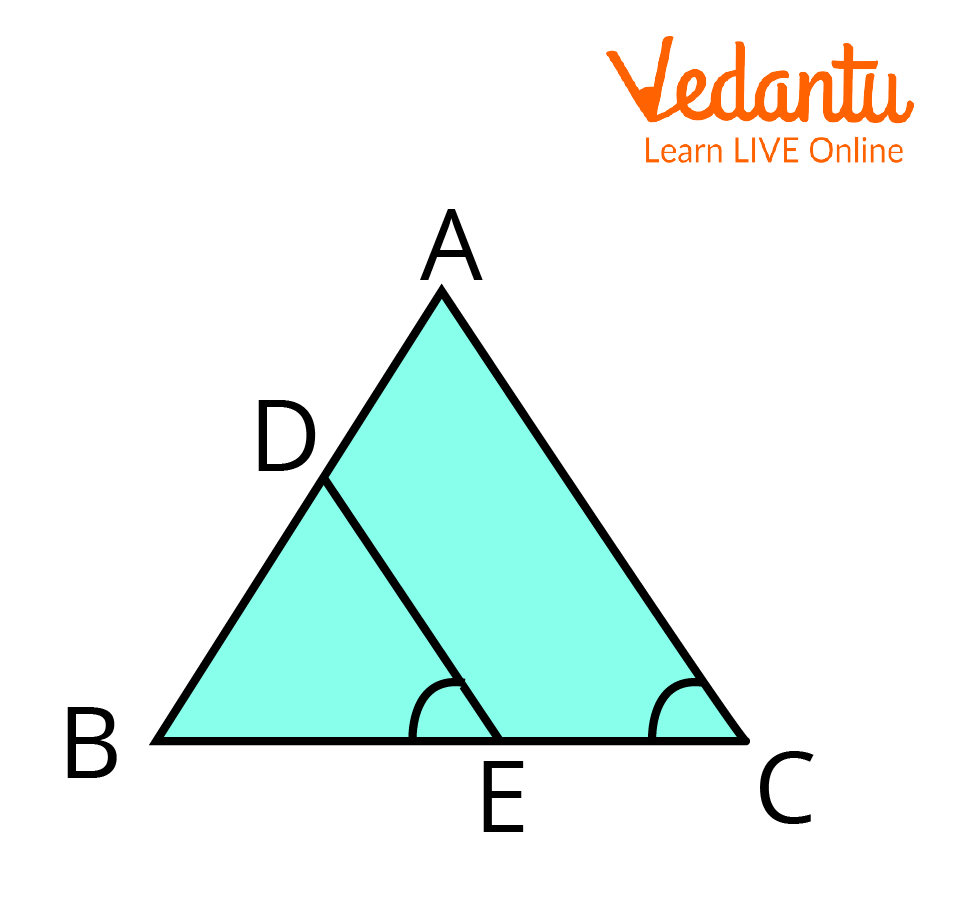




Step-by-Step Proof and Questions on the Equal Intercept Theorem
The is a fundamental tool of Euclidean Geometry. The concept of parellel lines and transversal is of great importance in our day-to-day life. And, the Equal intercept theorem extends our understanding of parallel lines and transversal and we can apply these concepts in our day-to-day life. In this article, we will see detailed proof of the theorem and the converse of the equal intercept theorem. We will solve some examples based on the concept of the theorem to strengthen our concepts and their application.
History of Mathematician

Euclid
Name: Euclid
Born: 325 BC
Died: 265 BC
Field: Mathematics
Nationality: Egypt
Statement of Equal Intercept Theorem
Equal Intercept Theorem states that if equal intercepts are made on three or more parallel lines by a transversal, then the intercept made by any other line on these lines will also be equal.
Equal Intercept Theorem Proof

Proof of Equal Intercept Theorem
Given: Lines $l, m$, and $n$ such that $l\parallel m\parallel n, p$ is a transversal that cuts $l, m, n$ at $A, B, C$, respectively, such that $A B=B C$. Also, $\mathrm{q}$ is another transversal.
To Prove: $P Q=Q R$
Construction: Through $\mathrm{Q}, \mathrm{draw}$ a line $r$ such that $r \parallel$ $p$
Proof:
By construction, the pair of opposite sides are parallel.
Opposite sides of the parallelogram are equal.
We have,
$r \parallel p$
As the pair of opposite sides are parallel.
Therefore, $A B Q X$ is a parallelogram.
$A B=X Q \quad \ldots$ (i) (Opposite sides of a parallelogram)
$B C=Q Y \quad \ldots$ (ii) (Given)
Given $A B=B C$ And $X Q=Q Y \ldots$ (3) $[$ From $(i)$ and $(i i)]$
Now, in $\triangle P Q X$ and $\triangle R Q Y$,
$\angle P Q X=\angle R Q Y$ Vertically opposite angles
$X Q=Q Y \quad[$ From (iii)]
$\angle P Q X=\angle R Y Q \quad$ (Alternate angles, $l \| n$, )
Therefore, by ASA congruence,
$\triangle P Q X$ and $\triangle R Q Y$ are congruent.
So, By CPCT, we can conclude that $P Q=Q R$.
Hence proved.
Limitations of Equal Intercept Theorem
The equal intercept theorem is applicable only in the case of parallel lines.
Applications of Equal Intercept Theorem
The equal Intercept Theorem is used to find the ratio of intercepts made by other lines on the parallel lines.
It is used in understanding the concept of the midpoint theorem.
The equal intercept theorem is used to derive the concept of the Basic Proportionality theorem which is limited to the case of two parallel lines.
Solved Examples
1. In the triangle $A B C, D E \parallel B C$, then find the value of $EC$?

To find the value of EC
Ans:
Given, $D E \parallel B C$.
According to the basic proportionality theorem, a line drawn parallel to one side divides the other sides in an equal ratio.
So, $\dfrac{A D}{D B}=\dfrac{A E}{E C}$
$\Rightarrow \dfrac{1.5}{3}=\dfrac{1}{E C}$
$\Rightarrow \dfrac{1}{2}=\dfrac{1}{E C}$
$\Rightarrow E C=2$
Hence, the value of $E C$ is $2 \mathrm{~cm}$.
2. In the triangle $A B C, D E \parallel B C$, then find the value of $AD$?

In triangle ABC, we need to find AD
Ans:
Given, $D E \parallel B C$.
According to the basic proportionality theorem, a line drawn parallel to one side divides the other sides in an equal ratio.
So, $\dfrac{A D}{D B}=\dfrac{A E}{E C}$
$\Rightarrow \dfrac{A D}{5}=\dfrac{3}{7.5}$
$\Rightarrow \dfrac{A D}{1}=\dfrac{15}{7.5}$
$\Rightarrow A D=2$
Hence, the value of $A D$ is $2 \mathrm{~cm}$.
3. In $\triangle A B C, D$ is the midpoint of $A B$ and $E$ is the midpoint of $B C$.
Calculate $D E$, if $A C=8.6 \mathrm{~cm}$.

In a triangle ABC, D and E are midpoints of AB and BC.
Ans:
In $\triangle A B C, D$ and $E$ are the mid-points of $A B$ and $B C$, respectively.
Hence, by mid-point theorem, $DE \parallel A C$
and
$D E=\dfrac{1}{2} A C$
$D E=\dfrac{1}{2} A C=\dfrac{1}{2} \times 8.6$
We get
$DE = 4.3 \mathrm{~cm}$
Important Points to Remember
The intercept made by a transversal on three or more parallel lines is equal to the intercept made by other transversals.
The equal intercept theorem is a generalized version of Thales's Theorem.
Parallel Lines: If the distance between the lines is equal, then the lines are parallel.
Conclusion
In the above article, we have discussed the Equal Intercept Theorem and its proof followed by the converse of the equal intercept theorem. We have also discussed the applications of the theorem. So, we can conclude that Equal Intercept Theorem is a fundamental tool of Geometry and is based on applications of parallel lines and transversal and reduces our computational work based on its application as we have seen in the examples based on the theorem.
FAQs on Equal Intercept Theorem Explained for Students
1. What is the Equal Intercept Theorem in geometry?
The Equal Intercept Theorem states that if a transversal makes equal intercepts on three or more parallel lines, then any other transversal intersecting the same parallel lines will also make equal intercepts. In simpler terms, if one line cuts a set of parallel lines into equal segments, every other line that cuts them will also be divided into equal segments.
2. How is the Equal Intercept Theorem different from the Basic Proportionality Theorem (BPT)?
The main difference lies in their scope and application. The Basic Proportionality Theorem (BPT), or Thales's Theorem, is specific to triangles, stating that a line drawn parallel to one side divides the other two sides proportionally. The Equal Intercept Theorem is more general; it applies to any set of three or more parallel lines and the transversals that intersect them, not just within a triangle.
3. What are parallel lines and transversals in the context of this theorem?
In the context of the Equal Intercept Theorem:
- Parallel Lines are three or more straight lines in a plane that never intersect, no matter how far they are extended.
- A Transversal is a line that intersects this set of parallel lines at distinct points. The theorem requires at least two transversals to demonstrate the relationship between the intercepts.
4. Can you provide a real-world example of the Equal Intercept Theorem?
A classic real-world example is a ruled notebook or a sheet of lined paper. The horizontal lines on the paper are parallel and equidistant (making equal intercepts). If you draw a straight diagonal line (a transversal) across these lines, the segments of your diagonal line between each pair of consecutive horizontal lines will be equal in length. This principle is used in design and architecture to ensure proportional division.
5. What is the proof for the Equal Intercept Theorem?
The proof of the Equal Intercept Theorem generally involves constructing triangles and using the principles of congruence or the converse of the Mid-Point Theorem. The key steps are:
- Draw lines through the intersection points of one transversal, parallel to the second transversal.
- This construction creates a series of triangles between the parallel lines.
- By using the Angle-Side-Angle (ASA) or Angle-Angle-Side (AAS) congruence rule, you can prove that these triangles are congruent.
- Since the triangles are congruent, their corresponding sides are equal, which proves that the intercepts made on the second transversal are also equal.
6. Why is the concept of 'equal intercepts' on the first transversal so important?
The condition of 'equal intercepts' on the first transversal is the fundamental premise of the theorem. It establishes a uniform spacing between the parallel lines. This uniformity is what guarantees that any other transversal, regardless of its angle, will also be cut into equal segments. If the initial intercepts were not equal, the parallel lines would be spaced irregularly, and the intercepts on other transversals would be proportional but not necessarily equal.
7. How is the Equal Intercept Theorem used to find unknown lengths in a geometric figure?
This theorem is a powerful tool for finding unknown lengths without complex calculations. If you can establish that three or more lines are parallel and that a transversal cuts them into equal segments (e.g., a segment of length 'x'), you can immediately conclude that any other transversal will also be cut into equal segments of some other length 'y'. If you know the total length of the second transversal, you can find the length of each intercept by dividing the total length by the number of intercepts.
8. What is a common mistake students make when applying the Equal Intercept Theorem?
A common mistake is assuming the theorem applies when there are only two parallel lines. The Equal Intercept Theorem explicitly requires three or more parallel lines to be valid. Another error is confusing the lengths of intercepts on different transversals; while the intercepts on one transversal are equal to each other (e.g., AB = BC), they are not necessarily equal to the intercepts on another transversal (e.g., AB ≠ DE), unless the transversals are parallel.





































